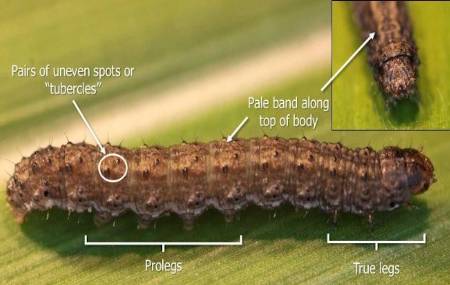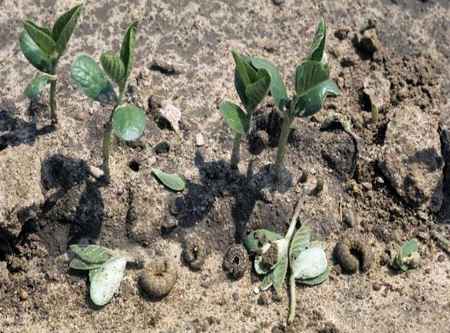By Adam Varenhorst
Typically, we are concerned with black cutworm activity in corn fields. However, 2020 has been anything but a typical year and we are instead concerned with black cutworm activity in soybean fields. Fields that were prevent plant last year and had early weed pressure this season have the greatest risk for black cutworm pressure. Black cutworms migrate to South Dakota every spring, and the strong southerly winds that we experienced likely helped them find their way north. Black cutworm activity within a field is normally patchy, but the entire field should be scouted to determine the extent of the infestation.
Identification
Black cutworm caterpillars range in color from light gray to brown to black and have a pale band that runs the length of the body along the top of the caterpillar. Caterpillars appear to have rough or “pebbly” texture because their skin is covered with pairs of uneven sized spots (tubercles) located on the sides and near the top of each abdominal segment (Figure 1). These spots can be used to separate black cutworm from dingy cutworm (dingy cutworms have equal sized spots). Head capsules of black cutworm caterpillars have two black stripes. Black cutworm caterpillars also have three pairs of true legs and four pairs of abdominal prolegs. When fully mature, caterpillars are approximately 1.5 inches in length.

Figure 1. Black cutworm caterpillar.
Injury to Soybeans
Black cutworm caterpillars feed on plant tissues close to the soil surface; caterpillars prefer to not climb plants. Stand reduction occurs when caterpillars become large enough to cut plants at the base (Figure 2).

Figure 2. Black cutworm caterpillars cut soybean plants near the soil surface.
Scouting
Scouting for black cutworm is difficult because caterpillars are nocturnal and hide during the day. Therefore, scouting revolves around finding soybean plants with signs of caterpillar feeding either on the leaves, around the base of the stem, or the presence of cut plants. Scouting should begin at emergence (VE) and continue weekly. Watch for areas with stand reduction as this may be an indicator of black cutworm activity. An insecticide treatment is recommended if greater than 20% of soybean plants are cut or defoliated and any black cutworm caterpillars that are found are less than 1 inch in long.
Management
Therapeutic management of black cutworm used in conjunction with scouting for feeding injury and caterpillars is also effective. Currently registered insecticides for management of black cutworm in soybean are listed in the current edition of the South Dakota Pest Management Guide: Soybeans. Because cutworms are nocturnal and hide under debris and soil during the day, the timing of the treatment is very important to ensure adequate coverage.
Source : sdstate.edu